What's inside
What's inside
 Key Ingredients
Key Ingredients

 Benefits
Benefits

 Concerns
Concerns

No concerns
 Ingredients Side-by-side
Ingredients Side-by-side

Water
Skin ConditioningGlycerin
HumectantButylene Glycol
HumectantDipropylene Glycol
Humectant1,2-Hexanediol
Skin ConditioningMethyl Gluceth-10
EmulsifyingSodium Hyaluronate
HumectantCarbomer
Emulsion StabilisingPanthenol
Skin ConditioningTromethamine
BufferingEthylhexylglycerin
Skin ConditioningHyaluronic Acid
HumectantHydrolyzed Hyaluronic Acid
HumectantGluconolactone
Skin ConditioningLactobionic Acid
BufferingWater
Skin ConditioningMethylpropanediol
SolventBifida Ferment Lysate
Skin ConditioningGlycerin
HumectantNiacinamide
SmoothingDimethicone
EmollientPentylene Glycol
Skin ConditioningDipropylene Glycol
HumectantGlycereth-26
HumectantCentella Asiatica Extract
CleansingPropylene Glycol
HumectantMaris Aqua
HumectantCeramide NP
Skin ConditioningPanthenol
Skin ConditioningCeramide Ns
Skin ConditioningCeramide As
Skin ConditioningCeramide EOP
Skin ConditioningCeramide AP
Skin ConditioningSodium Hyaluronate
HumectantPEG-60 Hydrogenated Castor Oil
EmulsifyingHydroxyethyl Urea
HumectantBis-PEG-18 Methyl Ether Dimethyl Silane
Emollient4-T-Butylcyclohexanol
MaskingUbiquinone
AntioxidantPEG-10 Dimethicone
Skin ConditioningIsononyl Isononanoate
EmollientAmmonium Acryloyldimethyltaurate/Beheneth-25 Methacrylate Crosspolymer
Emulsion StabilisingBisabolol
MaskingEctoin
Skin ConditioningAmmonium Polyacryloyldimethyl Taurate
Emulsion StabilisingTocopherol
AntioxidantLactobacillus/Soymilk Ferment Filtrate
Skin ConditioningHydrogenated Lecithin
EmulsifyingHamamelis Virginiana Extract
AntiseborrhoeicZingiber Officinale Root Extract
Masking1,2-Hexanediol
Skin ConditioningPolyacrylate Crosspolymer-6
Emulsion StabilisingC12-20 Alkyl Glucoside
EmulsifyingO-Cymen-5-Ol
AntimicrobialHydroxyacetophenone
AntioxidantDimethiconol
EmollientSodium Polyacrylate
AbsorbentGlucose
HumectantWater, Methylpropanediol, Bifida Ferment Lysate, Glycerin, Niacinamide, Dimethicone, Pentylene Glycol, Dipropylene Glycol, Glycereth-26, Centella Asiatica Extract, Propylene Glycol, Maris Aqua, Ceramide NP, Panthenol, Ceramide Ns, Ceramide As, Ceramide EOP, Ceramide AP, Sodium Hyaluronate, PEG-60 Hydrogenated Castor Oil, Hydroxyethyl Urea, Bis-PEG-18 Methyl Ether Dimethyl Silane, 4-T-Butylcyclohexanol, Ubiquinone, PEG-10 Dimethicone, Isononyl Isononanoate, Ammonium Acryloyldimethyltaurate/Beheneth-25 Methacrylate Crosspolymer, Bisabolol, Ectoin, Ammonium Polyacryloyldimethyl Taurate, Tocopherol, Lactobacillus/Soymilk Ferment Filtrate, Hydrogenated Lecithin, Hamamelis Virginiana Extract, Zingiber Officinale Root Extract, 1,2-Hexanediol, Polyacrylate Crosspolymer-6, C12-20 Alkyl Glucoside, O-Cymen-5-Ol, Hydroxyacetophenone, Dimethiconol, Sodium Polyacrylate, Glucose
 Reviews
Reviews

Ingredients Explained
These ingredients are found in both products.
Ingredients higher up in an ingredient list are typically present in a larger amount.
1,2-Hexanediol is a synthetic liquid and another multi-functional powerhouse.
It is a:
- Humectant, drawing moisture into the skin
- Emollient, helping to soften skin
- Solvent, dispersing and stabilizing formulas
- Preservative booster, enhancing the antimicrobial activity of other preservatives
Dipropylene Glycol is a synthetically created humectant, stabilizer, and solvent.
This ingredient helps:
Dipropylene glycol is technically an alcohol, but it belongs to the glycol family (often considered part of the ‘good’ alcohols). This means it is hydrating and gentle on skin unlike drying solvent alcohols like denatured alcohol.
As a masking agent, Dipropylene Glycol can be used to cover the smell of other ingredients. However, it does not have a scent.
Studies show Dipropylene Glycol is considered safe to use in skincare.
Learn more about Dipropylene GlycolGlycerin is already naturally found in your skin. It helps moisturize and protect your skin.
A study from 2016 found glycerin to be more effective as a humectant than AHAs and hyaluronic acid.
As a humectant, it helps the skin stay hydrated by pulling moisture to your skin. The low molecular weight of glycerin allows it to pull moisture into the deeper layers of your skin.
Hydrated skin improves your skin barrier; Your skin barrier helps protect against irritants and bacteria.
Glycerin has also been found to have antimicrobial and antiviral properties. Due to these properties, glycerin is often used in wound and burn treatments.
In cosmetics, glycerin is usually derived from plants such as soybean or palm. However, it can also be sourced from animals, such as tallow or animal fat.
This ingredient is organic, colorless, odorless, and non-toxic.
Glycerin is the name for this ingredient in American English. British English uses Glycerol/Glycerine.
Learn more about GlycerinPanthenol is a common ingredient that helps hydrate and soothe the skin. It is found naturally in our skin and hair.
There are two forms of panthenol: D and L.
D-panthenol is also known as dexpanthenol. Most cosmetics use dexpanthenol or a mixture of D and L-panthenol.
Panthenol is famous due to its ability to go deeper into the skin's layers. Using this ingredient has numerous pros (and no cons):
Like hyaluronic acid, panthenol is a humectant. Humectants are able to bind and hold large amounts of water to keep skin hydrated.
This ingredient works well for wound healing. It works by increasing tissue in the wound and helps close open wounds.
Once oxidized, panthenol converts to pantothenic acid. Panthothenic acid is found in all living cells.
This ingredient is also referred to as pro-vitamin B5.
Learn more about PanthenolSodium Hyaluronate is hyaluronic acid's salt form. It is commonly derived from the sodium salt of hyaluronic acid.
Like hyaluronic acid, it is great at holding water and acts as a humectant. This makes it a great skin hydrating ingredient.
Sodium Hyaluronate is naturally occurring in our bodies and is mostly found in eye fluid and joints.
These are some other common types of Hyaluronic Acid:
Learn more about Sodium HyaluronateWater. It's the most common cosmetic ingredient of all. You'll usually see it at the top of ingredient lists, meaning that it makes up the largest part of the product.
So why is it so popular? Water most often acts as a solvent - this means that it helps dissolve other ingredients into the formulation.
You'll also recognize water as that liquid we all need to stay alive. If you see this, drink a glass of water. Stay hydrated!
Learn more about Water